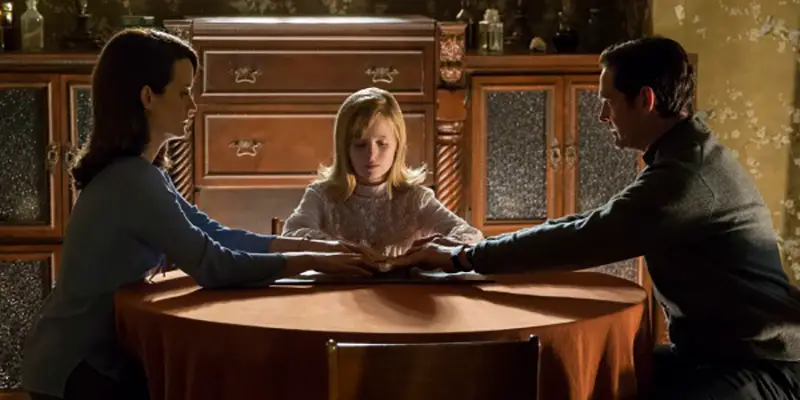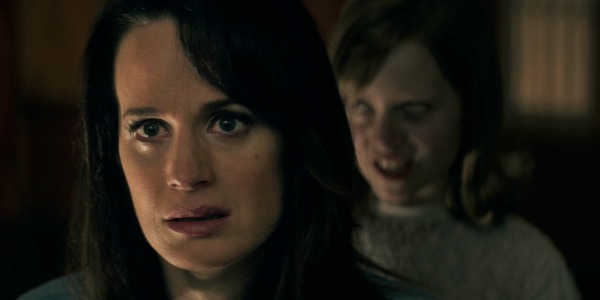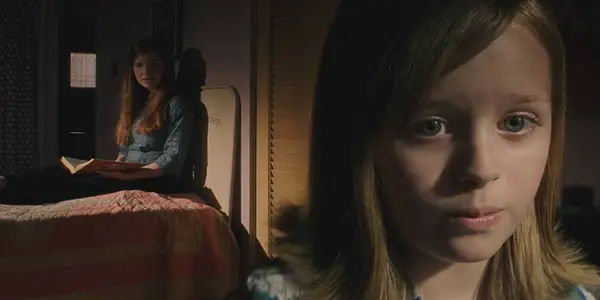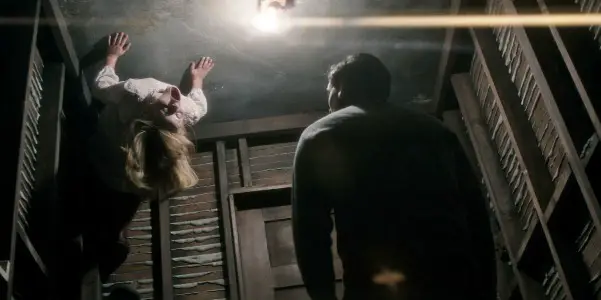OUIJA: ORIGIN OF EVIL: A Scarily Good Horror Prequel

Jim Dixon retired from practicing law not a moment too…
Is this any way to sell a board game? Hasbro’s perennial moneymaker “Ouija” is the basis of Universal’s micro-budget horror franchise in the making, and it’s hard to imagine a game manufacturer working any harder to discourage people from buying its product. The 2014 release Ouija opened at number one, and a followup was inevitable. Universal opted for the prequel route, which has the advantage of not requiring the audience to have seen the first movie.
In fact, one of the odd advantages Ouija: Origin of Evil manages to successfully exploit is the fact that audiences who have seen the first movie will probably have difficulty recognizing its links to the current one.
Ouija: Origin of Evil is in many ways actually superior to the first movie, serving up plenty of scares in the Insidious/Conjuring style. Benefiting substantially from a well-timed pre-Halloween release date and no significant genre competition, this solidly-executed followup should have no trouble matching the box office success of its predecessor.
Prequel Set in the ’60s
In 1967 Los Angeles, widowed mother Alice Zander (Twilight’s Elizabeth Reaser) and her two daughters Lina (Annalise Basso) and Doris (Lulu Wilson) add a Ouija board as a new stunt to bolster the family business – scam séances – and unwittingly open communication with real, and unfriendly spirits. Doris seems to have particular talent at speaking to spirits in another realm, and while the characters are kept in the dark about what’s truly going on, the audience knows virtually from the get-go that the ghosts she’s making contact with aren’t friendly. When little Doris is possessed by a malevolent entity (Doug Jones), all hell starts to break loose.

The original Ouija relied heavily on its teenage protagonists doing dumb stuff that they’d been specifically warned not to do. The prequel cleverly avoids some, if not all, of these pitfalls. The Ouija board comes with instructions that warn that the user should never play alone, never play in a graveyard and always say goodbye. But Alice starts out as a skeptic, and it isn’t clear that Doris, who is much younger than the main characters of the first movie, actually knows all the rules. As to playing in a graveyard, if you don’t know about the bodies buried in your basement, how are you supposed to do that one?
Good Performances, But the Kids Steal the Show
Reaser provides unexpected depth to what could have been a stock genre character, and the younger performers are even better. Basso vividly conveys credible teenage angst, but much of the movie falls on the shoulders of 10-year-old horror veteran Lulu Wilson (Deliver Us from Evil). She’s up to the challenge, unnervingly balancing Doris’ innocence and evil. Sugar and spice and everything nice one minute, she turns malevolent enough to scare the pants off Linda Blair the next.
Casually delivering a monologue on what it feels like to be strangled to death with an innocent smile, Wilson elicits screams without raising her own voice. (One shudders, or chuckles, at the thought of young acting students who may turn to this scene as an audition monologue). To be sure, she’s aided by some effective CG effects, stretching her mouth to inhuman proportions, and strategic dubbing when spectral voices have to come out of it, but the casting here is critical to the movie’s effectiveness. A possessed little kid may be one of the biggest horror clichés there is, but Wilson is a genuine find.

With this kid around, you wonder why any visitors would even stay long enough for tea, but horror movie logic is horror movie logic and so they do. The visitors include Lina’s boyfriend (Parker Mack) and a Catholic priest, played by Henry Thomas of E.T. fame, and before long they’re all at the Zander home trying to figure out why little Doris is acting so oddly. The best a character can hope for is to live to regret it, but no spoilers will be found here.
Thomas’ character is a particularly welcome addition – a sympathetic priest whose interest in the children at the Catholic school where he serves as principal is genuinely benevolent. His character is also a widower, who entered the priesthood after the untimely death of his well-loved wife. He and Alice are clearly drawn to each other, and it’s almost a shame the movie doesn’t provide the room for more of a romantic subplot. A scene where the two meet at a restaurant for dinner to discuss Alice’s daughters is deliciously awkward.
Director Mike Flanagan Knows How it’s Done
Director Mike Flanagan (Oculus, Hush) plays the game in Ouija: Origin of Evil like a seasoned pro. Horror movie audiences have known since the ’70s that a dark corridor is a dark corridor, whether it’s in a haunted house or a starship. Halloween and Alien, to a very large degree, milked the same tactics in very similar ways. Misdirection is as critical to a horror movie as it is to a stage magician. You establish a lot of ostensibly empty but shadowy spaces in a shot, and the audience reflexively expects something scary to emerge from it. The true maestro exploits that but makes sure that when the monster or psycho killer does enter, it’s from an entirely different direction.

Similarly, Flanagan takes stock of the tactics that worked in Ouija, not to imitate them, but again to confound audience expectations. In the first movie, characters looked through the center lens of the Ouija board’s planchette and saw previously unseen ghosts, frequently right on top of them. Flanagan dangles that situation in front of his audience, but almost never lets us look through the planchette. In one particularly unnerving scene, Doris looks through the planchette, but Flanagan obstinately refuses to cut to a point of view shot. Doris then puts the board down, looks up into the room and asks “Who are you?” to an unseen presence.
Flanagan fully embraces the ’60s setting, opening the film with a retro Universal logo card, and has a ball with period atmosphere with clever set decoration, graphics which evoke the Ouija board itself, and vintage music. He even inserts the old cigarette burns in the upper corner of the frame, that used to warn projectionists of impending reel changes (an anachronism in the digital age).
Michael Fimognari’s deep-focus, autumnal cinematography both establishes a nostalgic feel on the one hand and builds suspense on the other. Scary business is periodically glimpsed in the background, ratcheting up the tension with a slick efficiency that the Paranormal Activity movies would envy and do well to emulate. Ouija: Origin of Evil initially unfolds more leisurely than its predecessor, but successfully builds suspense as it establishes characters worth caring about. Once the movie enters its final act, it goes into full funhouse mode, with no let-up until the last shot. There is virtually no onscreen gore in the film, though there is plenty of genuinely unsettling imagery that pushes the boundary of the PG-13 rating.
Stay For the End Credits
Moviegoers should also note that there is a scene after the end credits, featuring veteran horror actress Lin Shaye, and linking Ouija: Origin of Evil to its 2014 predecessor.
An effective, even superior prequel, and reportedly made for a paltry $6 million, Ouija: Origin of Evil looks like a sure bet to be a Halloween hit, and may well launch the franchise Universal is certainly hoping for.
What do you think? Does Ouija: Origin of Evil have what it takes to turn into a major horror franchise?
Ouija: Origin of Evil is playing in cinemas in the United States and the United Kingdom. Find international release dates here.
Does content like this matter to you?
Become a Member and support film journalism. Unlock access to all of Film Inquiry`s great articles. Join a community of like-minded readers who are passionate about cinema - get access to our private members Network, give back to independent filmmakers, and more.
Jim Dixon retired from practicing law not a moment too soon, and now works as a freelance writer and film critic. A lifelong and unrepentant movie geek, he firmly believes that everything you need to know in life you can learn at the movies. He lives in upstate New York.













